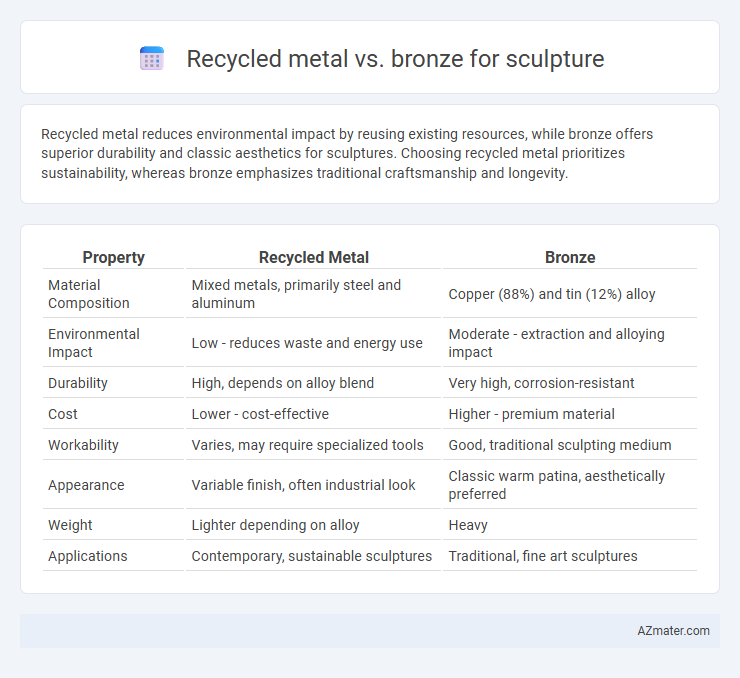Recycled metal reduces environmental impact by reusing existing resources, while bronze offers superior durability and classic aesthetics for sculptures. Choosing recycled metal prioritizes sustainability, whereas bronze emphasizes traditional craftsmanship and longevity.
Table of Comparison
| Property | Recycled Metal | Bronze |
|---|---|---|
| Material Composition | Mixed metals, primarily steel and aluminum | Copper (88%) and tin (12%) alloy |
| Environmental Impact | Low - reduces waste and energy use | Moderate - extraction and alloying impact |
| Durability | High, depends on alloy blend | Very high, corrosion-resistant |
| Cost | Lower - cost-effective | Higher - premium material |
| Workability | Varies, may require specialized tools | Good, traditional sculpting medium |
| Appearance | Variable finish, often industrial look | Classic warm patina, aesthetically preferred |
| Weight | Lighter depending on alloy | Heavy |
| Applications | Contemporary, sustainable sculptures | Traditional, fine art sculptures |
Introduction: The Evolution of Sculpture Materials
Sculpture materials have evolved significantly from traditional bronze to sustainable alternatives like recycled metal, reflecting environmental awareness and innovation in art. Bronze, an alloy primarily of copper and tin, offers durability and a classic aesthetic, while recycled metal incorporates scrap materials, reducing ecological footprint and conserving resources. This shift highlights a growing preference for eco-friendly practices without compromising artistic integrity or structural strength.
What is Recycled Metal?
Recycled metal refers to materials salvaged and repurposed from discarded metal objects, reducing the need for new ore extraction and lowering environmental impact. In sculpture, recycled metal offers an eco-friendly alternative with diverse textures and patinas, often retaining the durability and strength seen in traditional bronze. While bronze, an alloy primarily of copper and tin, provides classic aesthetic and corrosion resistance, recycled metals contribute sustainability and unique visual elements to contemporary art.
Bronze: Historical and Artistic Significance
Bronze has been the preferred material for sculptures since ancient civilizations due to its durability, malleability, and ability to capture fine details with a smooth finish. Its historical significance is rooted in iconic works such as the Greek Riace Warriors and the Renaissance masterpieces of Benvenuto Cellini, highlighting its enduring artistic value. Bronze's unique alloy composition of copper and tin enhances corrosion resistance, making it ideal for both indoor and outdoor sculptures that stand the test of time.
Comparing Aesthetics: Recycled Metal vs Bronze
Recycled metal sculptures often exhibit a rugged, industrial aesthetic characterized by varied textures and patinas unique to reclaimed materials, offering a contemporary and eco-friendly appeal. Bronze sculptures present a classic, timeless finish with smooth surfaces and rich, warm tones that develop a natural patina over time, enhancing their depth and sophistication. The choice between recycled metal and bronze hinges on the desired visual impact, with recycled metal favoring bold, textured artistry and bronze delivering refined elegance.
Durability and Longevity in Outdoor Sculptures
Recycled metal offers exceptional durability for outdoor sculptures due to its resistance to corrosion and weathering, often enhanced by protective coatings. Bronze, a traditional choice for sculptures, exhibits superior longevity enabled by its natural patina that protects against rust and environmental damage over centuries. Both materials withstand harsh outdoor conditions, but bronze's proven historical performance makes it a preferred option for sculptures intended to endure long-term exposure.
Environmental Impact of Material Choice
Recycled metal significantly reduces environmental impact by minimizing the need for virgin mining, conserving natural resources, and lowering greenhouse gas emissions during production compared to bronze. Bronze, an alloy of copper and tin, involves energy-intensive extraction and refining processes that contribute to habitat disruption and carbon footprint. Opting for recycled metals in sculpture promotes sustainability by reducing landfill waste and supporting circular economy principles in the art industry.
Cost Factors: Recycled Metal vs Bronze
Recycled metal sculptures typically cost 30-50% less than bronze due to lower raw material expenses and reduced manufacturing energy requirements. Bronze pricing fluctuates with copper and tin markets, often leading to higher and less predictable costs for artists and foundries. Choosing recycled metal can significantly reduce overall sculpture production budgets while supporting sustainable practices.
Workability and Artist Preferences
Recycled metal offers high workability due to its malleability and ability to be melted and reshaped multiple times, making it a versatile choice for artists seeking sustainability and cost-effectiveness. Bronze, favored for its superior durability, fine grain, and rich patina, is preferred by traditional sculptors focused on detail and long-lasting finish. Artists who value a mix of ease in manipulation and classic aesthetic often balance between recycled metal's flexibility and bronze's historic prestige.
Market Value and Collector Appeal
Recycled metal sculptures often carry a strong environmental narrative appealing to eco-conscious collectors, but bronze remains a timeless material with consistently high market value due to its durability and historical significance. Bronze sculptures typically command higher prices at auctions and galleries, supported by well-established traditions and recognized craftsmanship. The collector appeal of recycled metal hinges on innovation and uniqueness, whereas bronze attracts buyers valuing classic aesthetics and long-term investment stability.
Choosing the Right Material for Your Sculpture
Selecting the right material for your sculpture requires understanding the distinct properties of recycled metal and bronze. Recycled metal offers an eco-friendly option with diverse textures and a modern aesthetic, ideal for contemporary artworks and budget-conscious artists. Bronze provides timeless durability, detailed casting capabilities, and a classic patina finish, making it preferred for traditional sculptures and long-lasting outdoor installations.

Infographic: Recycled metal vs Bronze for Sculpture
 azmater.com
azmater.com